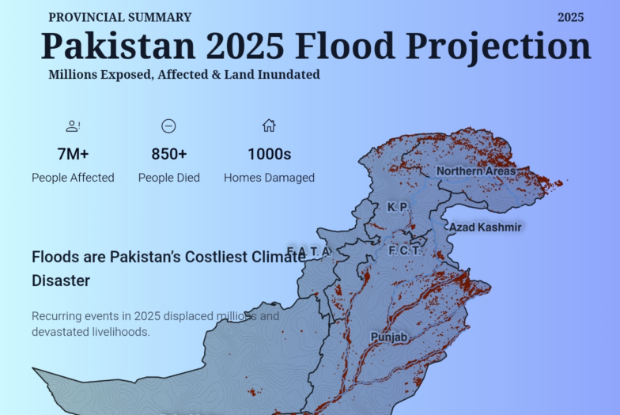Flood Impact Across Pakistan 2025
A Nation Underwater: Pakistan’s Floods in Focus
- Punjab: Most exposed province with large population affected by floods
- Sindh: Severely impacted province with widespread inundation
- Khyber Pakhtunkhwa: High flood exposure in northern and river belt areas
- Balochistan: Large land area affected, sparse but vulnerable population
- Gilgit-Baltistan: Mountainous region with flash floods and glacial lake outbursts
- Azad Jammu & Kashmir: River-based flooding, smaller scale compared to other provinces
- Islamabad Capital Territory: Localized flash flooding, limited population exposure

Visual Intelligence by FactsFigs.com
Flood Exposure & Impact Data 2025
Data Source: National Disaster Management Authority (NDMA), Pakistan
Overview
The nation, ranked as the 5th most vulnerable country to climate change by the Global Climate Risk Index, faces an annual battle against water. Pakistan has faced recurring floods in recent years, with devastating impacts on both people and land. From 2022 to 2025, millions of individuals were exposed to floodwaters, while vast agricultural and residential areas were inundated. The severity of these events varied across provinces, highlighting regional vulnerabilities and the urgent need for stronger disaster preparedness.
Flood Impact in Pakistan - Top 3 Provinces
The brunt of recent floods was borne by a few provinces where exposure and damage reached unprecedented levels. Punjab, Sindh, and Balochistan together accounted for the largest share of affected people and inundated land. Let’s look closer at how these provinces were impacted.
Punjab hit hardest with 4.3M people
Punjab, Pakistan’s most populous province, saw widespread flooding along river belts. Nearly 5 million people were exposed, with major damage to crops and rural communities.
Sindh exposed with 1.6M affected
Sindh has faced the brunt of recent floods, with over 1 million people affected. Vast agricultural lands, homes, and infrastructure were inundated, making it the most severely impacted province.
Khyber Pakhtunkhwa 1.57M affected
Khyber Pakhtunkhwa experienced flash floods and river overflows, leaving nearly 1.5 million people affected. Mountainous terrain amplified the damage in several districts.
Fast Facts: Other Provinces
- Azad Jammu & Kashmir 17K – River flooding in Azad Jammu & Kashmir displaced approximately many people. While smaller in scale, the impact was severe in localized areas.
- Balochistan 11K – Balochistan, though less populated, suffered large-scale land inundation. A large population were affected, with remote communities cut off due to damaged roads and infrastructure.
- Gilgit-Baltistan 7K – Gilgit-Baltistan faced glacial lake outburst floods (GLOFs), displacing thousands of people. The melting of glaciers has made the region increasingly vulnerable.
- Islamabad Capital Territory 2K – Islamabad experienced urban flash floods, with poor drainage causing waterlogging. Thousands of residents were affected, mostly in low-lying areas.
Understanding Pakistan's Flood Dynamics
The Monsoon Season: Pakistan's Annual Challenge
The South Asian monsoon is the lifeblood of the region's agriculture, but for Pakistan, it is also a source of immense risk. Typically lasting from June to September, these monsoon rains contribute the majority of the country's annual precipitation. The intensity and distribution of this rainfall across the Indus River Basin dictate the severity of riverine flooding, which affects the vast plains of Punjab and Sindh. Compounding this are flash floods in mountainous regions, creating a complex, nationwide hazard profile.
Glacial Melt, Snowpack, and Upstream Water Management
The pre-monsoon season is increasingly critical. Accelerated melting of Himalayan and Karakoram glaciers, which feed the Indus River system, is a major concern. An unusually warm spring can lead to higher-than-normal river flows even before the monsoon arrives, reducing the capacity of rivers and dams to absorb monsoon rainfall. This pre-loading of the river system is a significant early indicator of potential flood severity, requiring close monitoring of snowpack and glacial melt rates in Gilgit-Baltistan.
Conclusion
The floods of recent years have highlighted the scale of vulnerability across Pakistan, exposing millions of people and vast tracts of land to recurring disasters. Provinces like Punjab and Sindh have shouldered the heaviest toll, while regions such as Balochistan and Khyber Pakhtunkhwa continue to face mounting recovery challenges. “Flood resilience is no longer optional — it is essential for Pakistan’s future,” noted a climate risk expert. As climate change accelerates, strengthening infrastructure, improving early warning systems, and investing in adaptation measures will be vital to protect both lives and livelihoods.
Data Source and Attribution
Source: National Disaster Management Authority (NDMA), Pakistan
The data used in this visualization is sourced from NDMA’s official reports, supplemented with figures from UN OCHA and World Bank disaster assessments. It includes provincial breakdowns of people exposed, people affected, and land inundated during major flood events of 2025.
All values are approximate, rounded to the nearest million or thousands people or square kilometer where applicable. Provincial rankings are based on cumulative impact recorded over the covered period.
Last Verified: September 2025


